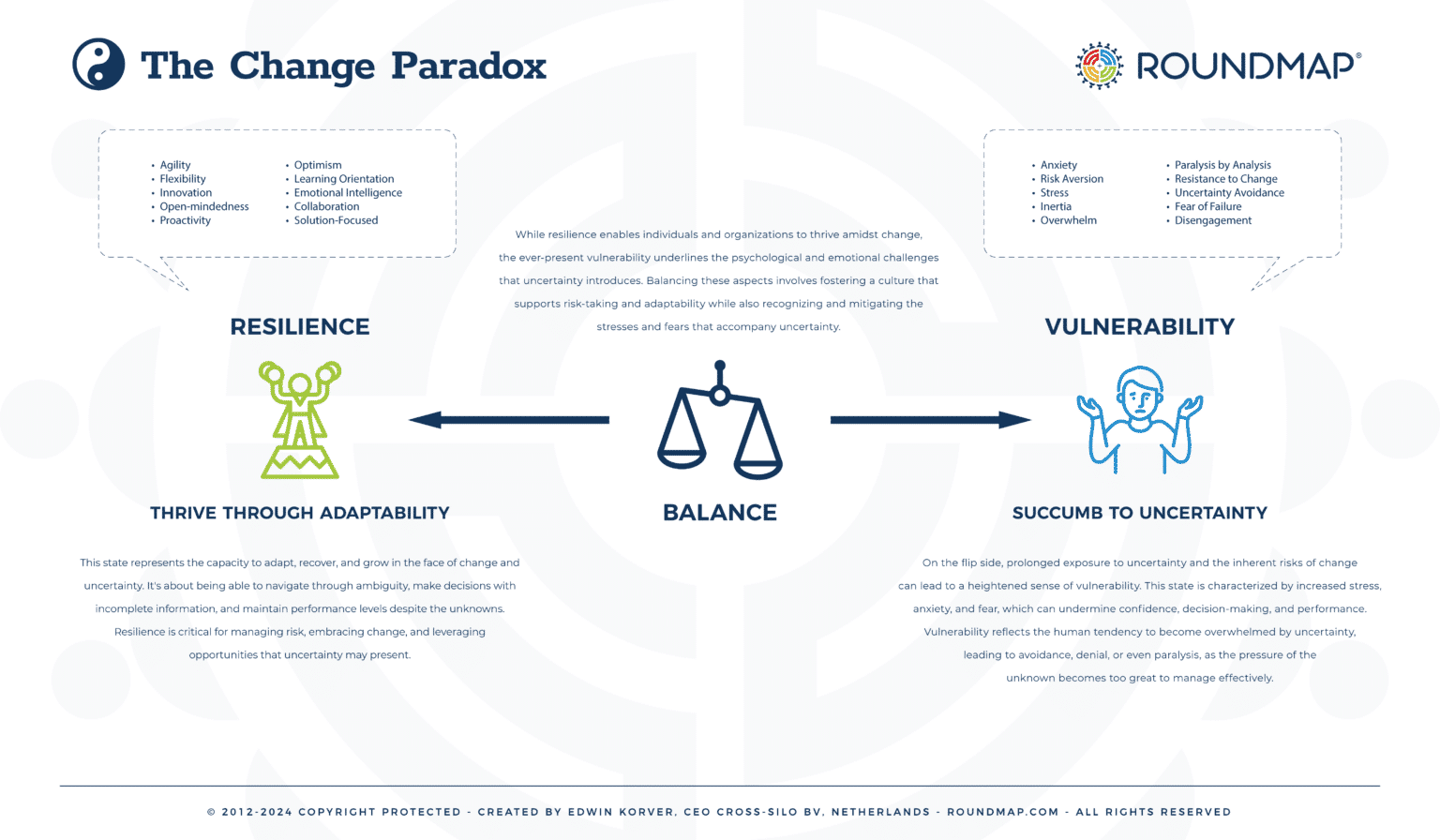You’ve read it before: change is not just inevitable; it’s the only constant. However, how individuals and organizations respond to change can significantly differ, leading to the Change Paradox. This paradox illustrates the fine line between vulnerability and resilience—how change that destabilizes can also be a powerful catalyst for growth and innovation.
The question is: “How can leaders cultivate resilience and adaptability in their teams to navigate the uncertainty of change, ensuring organizational sustainability and employee well-being?”
The Two Extremes: Vulnerability and Resilience
On one end of the spectrum lies vulnerability, where the uncertainty brought about by change leads to anxiety, fear, and ultimately, a decrease in performance. Individuals and organizations become paralyzed, succumbing to the pressures and challenges that change introduces. This reaction is natural, as humans are wired to seek stability and predictability in their environment.
On the opposite end is resilience, characterized by adaptability, learning, and growth. In this state, individuals and organizations not only withstand the pressures of change but thrive, using positive emotions, like hope and excitement, as a springboard for innovation and improvement. Resilience is built on the understanding that while we cannot control every aspect of change, we can control our response.
Bridging the Gap: Strategies for Navigating the Change Paradox
To effectively navigate the Change Paradox, leadership must recognize the dual nature of vulnerability and resilience in the face of uncertainty and actively work to bridge the gap between these extremes. This requires a nuanced approach, focusing on reducing uncertainty and fostering an environment where adaptability and resilience are cultivated. Here’s an integrated approach, including the final warning and additional strategies:
Leading with Insight: Understand the current state of your team and organization deeply. This involves recognizing the signs of vulnerability, such as decreased motivation or well-being, and addressing these issues proactively. By acknowledging and validating employees’ emotional and psychological challenges, leaders can create a more supportive and understanding work environment.
Leading with Foresight: Anticipating future challenges and changes allows leaders to prepare their teams for what lies ahead. This involves predicting potential market shifts or operational needs and understanding how these changes could impact employees’ mental and emotional states. By preparing for future uncertainties, leaders can help their teams navigate change with more confidence and less fear.
Promoting Realistic Optimism: Balancing the recognition of current challenges with a hopeful outlook on the future is essential. This involves acknowledging the difficulties and uncertainties while highlighting opportunities for growth and learning. By fostering a culture of realistic optimism, leaders can motivate their team to strive for success even in the face of adversity.
Encouraging Bigger-Picture Thinking: Helping employees see beyond the immediate challenges and understand their role in the organization’s larger mission can provide a sense of purpose and direction. This perspective encourages individuals to move beyond their immediate fears and to contribute to long-term goals and success.
Cultivating Emotional Resilience: Providing resources and support for emotional and psychological well-being is crucial. This could include access to mental health services, training on stress management techniques, or creating a workplace culture that prioritizes work-life balance.
Fostering a Culture of Continuous Learning: Encouraging a growth mindset and continuous improvement helps employees see change as an opportunity for development rather than a threat. This includes offering training and development opportunities and promoting a culture where feedback and learning from mistakes are valued.
From Paralysis to Potential
Leaders must act with compassion and foresight, understanding that waiting for events to happen and showing no concern over the mental state of employees facing high levels of uncertainty can lead to significant decreases in motivation, focus, agility, cooperative behavior, self-control, sense of purpose and meaning, and overall well-being. Research by Heidi Grant and Tal Goldhamer highlights the importance of countering the effects of uncertainty with realistic optimism and bigger-picture thinking to maintain a productive, motivated, and resilient workforce.
By integrating these strategies, leaders can bridge the gap between succumbing to uncertainty (paralysis) and fostering an organizational culture that thrives on adaptability and continuous growth (potential), ensuring long-term success in an ever-changing world.
Author
-
Edwin Korver is a polymath celebrated for his mastery of systems thinking and integral philosophy, particularly in intricate business transformations. His company, CROSS/SILO, embodies his unwavering belief in the interdependence of stakeholders and the pivotal role of value creation in fostering growth, complemented by the power of storytelling to convey that value. Edwin pioneered the RoundMap®, an all-encompassing business framework. He envisions a future where business harmonizes profit with compassion, common sense, and EQuitability, a vision he explores further in his forthcoming book, "Leading from the Whole."
View all posts Creator of RoundMap® | CEO, CROSS-SILO.COM






